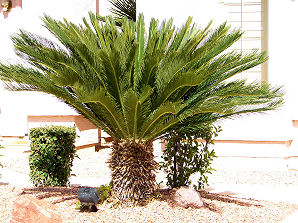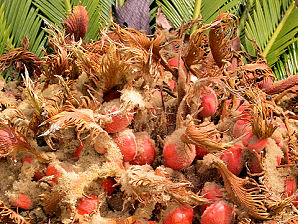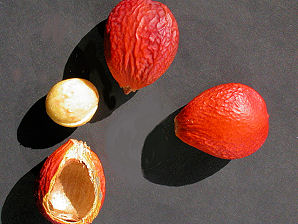Xeriscape Landscape Plants & Flowers
For The Arizona Desert Environment.
Pictures, Photos, Images, Descriptions, & Reviews.
Sago Palm, Cycas revoluta.
We Are Proud Of Our SafeSurf Rating!
Click On Any Of The Following Links By Amazon.Com
For Books, & Videos About Wildflowers Of Arizona & The Southwest USA. No Obligation!
| Sago Palm Tree, Cycas revoluta. Arrowhead Country Club; Glendale, Arizona. January 25, 2006. |
|---|
 | |
| Funeral Palm Tree, Cycas revoluta. | Sago Palm Tree, Cycas revoluta. |
|---|---|
 | |
| Funeral Palm Tree, Male Cones. | Sago Palm Tree, Female Cone. |
 |  |
| Funeral Palm Tree, Seeds. | Japanese Sago Palm, Seeds. |
 /
/

Sago Palm Tree.
We wish to thank Wikipedia, the free encyclopedia for some of the information on this page. We share images and information with Wikipedia. The Cycads are a group of plants that trace their origins back directly to plants that once thrived on the earth at the time of the dinosaurs. As such, they retain characteristics that are considered primitive when compared to the other living plants on the earth today. A fossil specimen, called Cycas fujiiana, is very similar to Cycas revoluta and dates to the Eocene Age deposits, 34 to 55 million years ago. Today about 10 genera of cycads still survive. The most commonly grown is the Japanese sago, also called the sago palm. While the cycads are a group of very primitive plants bearing a closel resemblance to palms, they are not at all related. Cycads are called "living fossils," since they reached their highest point of evolution in the Mesozoic Era (about 200 million years ago). The fossil cycads from the the Paleozoic (about 240 million years ago) have many characteristics similar to the cycads of today; thus, the name "living fossils". They are believed to be one of the most primitive of the seed-bearing plants and, as gymnosperms, are related to conifers. Cycas revoluta, or Sago Palm, is a cycad native to the Pacific Rim regions from the southern tip of the Japanese island of Kyushu, and the Ryukyu islands which include Okinawa and Iriomote. Here they grow on the nearvertical limestone cliffs around the coast or sometimes on the forest floors. Cycas revoluta, or Sago Palm, is a dioecious palm-like tree slowly forming hulking trunk to 12 feet or more high, requiring about 50 years to achieve this height. It is usually a solitary plant but sometimes it is branched, topped by a terminal crown of stiff, dark green, feathery pinnate frons 3 to 6 feet long. The feathery leaflets are spine-tipped and rolled at their margins; the petal - less flowers are in terminal clusters of brown - wooly carpels, in the female trees containing the orange to red - brown fruit, covering the nut - like poisonous seeds. The very distinctive leaves grow to about 4 - 5 feet in length and are about 9 inches in width. The leaves are pinnate and are composed of a rigid midrib with glossy leaflets arranged in a plane along its length. These leaflets are revolute which means that they curl under along their edge, thus, the plant's species name (C. revoluta). The sago is considered the most attractive when it's new leaves appear in the late spring or early summer. The leaves emerge as light green spikes, that are arranged in a circle around the perimeter of the trunk. The leaves slowly uncoil to the final length of the leaf. Then, the individual leaflets unravel away from the midrib and the entire column of new leaves forms a rosette just above the existing crown of leaves. While in nature, the trunks will reach about 10 to 12 feet in height, if grown in containers, they stay relatively small. They are very slow growers, which make them great for Bonsai projects. They are hardy in USDA zones 9 - 12. If left in containers, they will very rarely produce cones. In nature they "bloom" in the spring. The Sago Palm is dioecious, meaning that each plant has either male or female cones (the reproductive part of a cycad). Sexuality in cycads is apparently controlled by sex chromosomes (unlike most of the higher plants). The male cones protrude and are shaped like a cone. It can grow to be 12 - 18 inches in length. The female cones are "lettace" shaped and are gold to a yellow brown in color. The female cone will slowly open when receptive to the pollen. The bright orange to red seeds are about 1 - 1 1/2 inch in diameter. As the plant matures, a branching of the thick stem may occur, which adds to the charm of this plant. Sago Palm also can produce suckers at its base forming a large multi-stem clump over time. You should plant Sago Palm in sandy, fast draining soil, preferably with some organic matter. It is also recommended to use a light mulch of bark or leaf mold. You should provide light feedings of balanced, slow release fertilizer granules or diluted liquid fertilizers. You should avoid strong fertilizers, such as fresh manure since they can damage the Sago Palm's coralloid roots (the specialized structures that host the blue-green algae that fix nitrogen from the air and make it available to the plant). Sago Palm does best in bright areas including full sun. The Sago can also handle full shade with no ill effect but, its leaves grow larger in the shade. The Sago Palm needs good drainage or it will rot. The Sago is drought resistant when mature. You must provide adequate amounts of moisture for good growth. Hint: Because of their shape and growing habit, sago palms are great leaf catchers. Therefore, plant them in a location that isn�t beneath a deciduous or leaf-shedding tree. Also, be careful of the sharp spines near the leaves!
Note: Warning!!! Animals that graze on Cycas leaves may exhibit permanent nuerological disorders. Cycas seed is sometimes suggested as a natural remedy for certain conditions - do not use it! All parts of this plant are toxic! There are numerous cases reported of dogs eating the seeds and dying! With the above warning being said. I have several growing in my own yards for over 40 years, & have found it to be a wonderful plant. I have a dog and cat. No problems!
Quick Notes:
Height: 2 - 12 feet. Average about 4 feet.
Flowers: Cycads are dioecious; the male has microsporophylls or "little-spore leaves" that produce pollen arranged in a strobilus, a bright yellow cone and the female has megasporophylls or "big-spore leaves" that produce ovules.
These appear as fuzzy yellow-brown distorted leaves and bear the seeds along the leaf edges.
Flowering Time: February - April.
Leaves: The leaves are a deep semiglossy green and about 20 � 59 inches long when the plants are of a reproductive age. They grow out into a feather-like rosette up to 3.3 feet in diameter. The crowded, stiff, narrow leaflets are 3.1 � 7.1 inches long and have strongly recurved or revolute edges. The basal leaflets become more like spines. The petiole or stems of the Sago Cycad are 2.4 � 3.9 inches long and have small protective barbs that must be avoided.
Trunk: Normally up to 1 - 12 inches in diameter.
Soil pH requirements:
Sun Exposure:
Elevation: Can be found growing from 0 - 2,000 feet.
Habitat: A very common landscape plant in Phoenix. Found mainly on the sea shore in southern.Japan. Thickets on hillsides on islands, sparse forests on mainland at elevations of 914 - 1,640 feet in Fujian, China
Miscellaneous: Leaf Photos Taken at Glendale, Arizona. January 25, 2006. Said to be hardy to 20 degrees F. We had two killed by frost at 15 degrees F. Very pool friendly.
|
We Are Proud Of Our SafeSurf Rating!



We Are Proud Of Our SafeSurf Rating!
Click On Any Of The Following Links By Amazon.Com
For Books, & Videos About Xerioscape Plants Of Arizona & The Southwest USA. No Obligation!
| © 1966 - Present, Audrey, Eve, & George DeLange |


